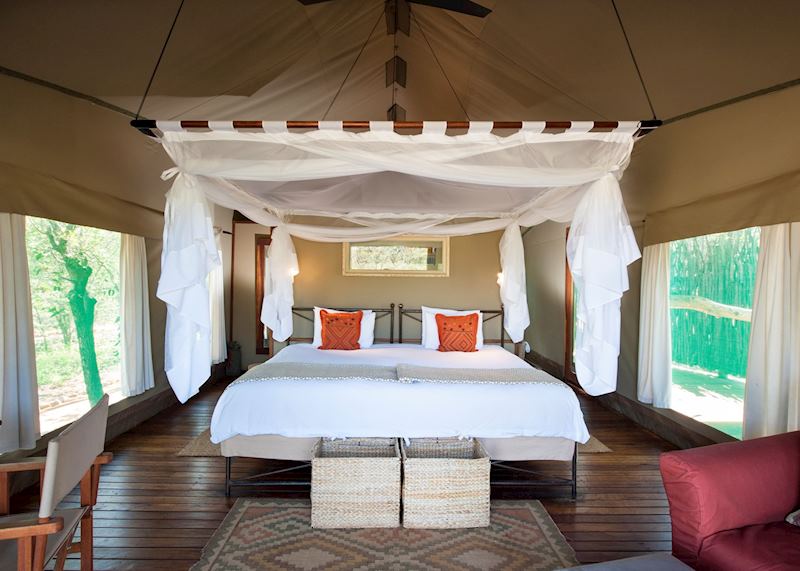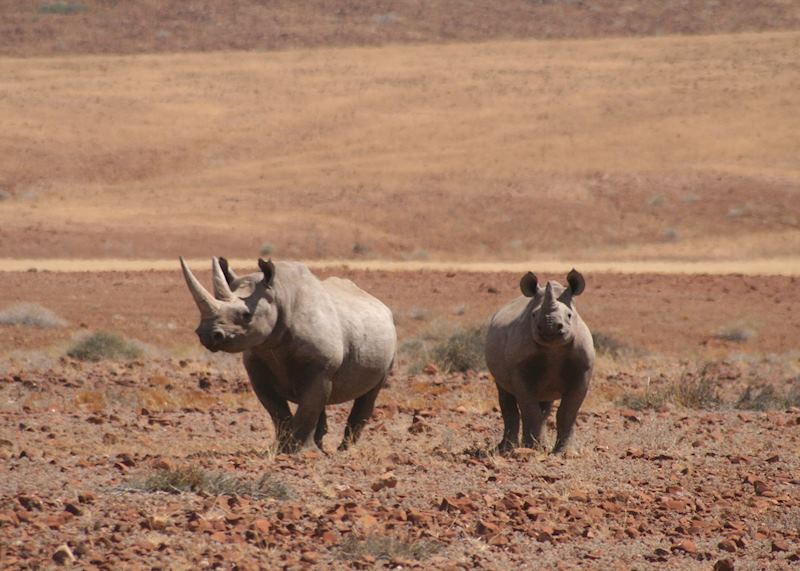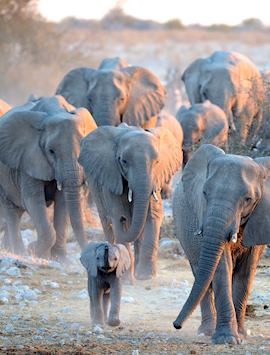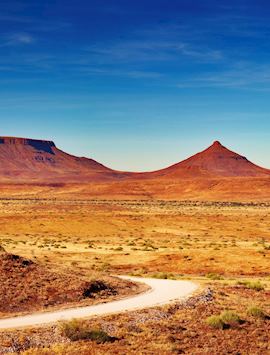Namibia specialist Alex
When I first visited Namibia, it took me by surprise. I’d expected it to be little more than empty desert stretching for miles. Instead, I discovered an eerily beautiful country of vast open spaces, huge sand dunes rolling out to the ocean and one of the largest national parks in Africa, Etosha.
A safari in Namibia, whether you’re self-driving, tracking animals on foot or heading out on a guided game drive, presents various wildlife spotting opportunities. You might see desert-adapted elephant and lion, large numbers of giraffe quenching their thirst at waterholes, and secretive rhino, whose tracks can be followed through the undergrowth.

Namibia lends itself to self-driving, which is the most common way to access the country’s different regions after arriving in Windhoek, Namibia’s capital. It’s also possible to explore in a private vehicle with a knowledgeable guide, or travel to different areas of the country by light aircraft.
Even in game parks and reserves, you’ll have the option to enjoy a self-drive safari. Roads are mostly made of gravel, but are well maintained and often pass by waterholes where you can stop to view the wildlife.
Camps and lodges in and around the park usually have their own experienced guides who take you out on game drives once or twice a day, which is another way to see the wildlife and to learn more about the habits of individual species.
Guided walking safaris are an option in some areas of Namibia and in the private reserves surrounding Etosha, but not in Etosha itself. These offer a more detailed experience where your guide will point out some of the smaller and less obvious wildlife species including insects to birds, although you might have the opportunity to track larger animals, like rhino, in some areas.
Etosha National Park

Encompassing more land than the Serengeti and Masai Mara combined, Etosha National Park, in the north of Namibia, is the country’s foremost safari destination. Home to four of the Big Five (it’s too dry for buffalo), the park has open grassland and mopane woodland where zebra, springbok and oryx — Namibia’s national animal — graze.
Almost a quarter of Etosha is taken up by salt pans, including the colossal Etosha Pan from which the park gets its name (which aptly means ‘great white place’). Visible from space, the salt shines brightly in the sun, stretching for miles into the horizon.
At first glance it appears to be an empty wasteland. Yet animals such as elephant, lion and wildebeest can be seen here, especially if there’s been recent rainfall, when they congregate around newly formed waterholes. The pan is also an important breeding ground for flamingoes — hundreds of thousands of them flock here during particularly rainy years, when the pan resembles an oasis.
The land surrounding the pan is well vegetated, so wildlife is able to thrive. What particularly stood out for me was the number of giraffe I saw in the park. Rising above the low-lying shrubs and trees, they moved in large herds that were incredible, and slightly amusing, to watch. I’d never seen so many together in one place.


Most camps and lodges are in private reserves a little outside the park, but there are a handful within Etosha. I stayed in Okaukuejo Rest Camp, a large camp with a village feel, set next to a waterhole. You can sit on wooden benches and watch elephant, giraffe and zebra come to drink, and in the evening the waterhole is lit up so you can see nocturnal species.
A highlight for me was seeing groups of rhino. By day, they tend to be elusive, solitary creatures, but when darkness falls they become more sociable. It’s not something you come across very often, so being able to witness them interacting with each other so nearby was a real treat.
Accommodation outside of the park tends to be of a high quality, consisting of smaller lodges with more a personal service. The best I’ve stayed at is Ongava Tented Camp in Ongava Private Game Reserve, which is just a 15- to 20-minute drive from the park’s southern entrance.
The traditionally-styled tents have en suite bathrooms and verandas, and there’s a waterhole that attracts a variety of endemic birds, such as Hartlaub's francolin and Ruppell’s parrot. Game drives and walking safaris are offered here, as well as rhino tracking.
Damaraland

The red, rocky landscape of Damaraland is one of Namibia’s least populated areas in terms of humans, but wildlife such as Hartmann’s mountain zebra, kudu and gemsbok thrive, and some animals have gradually evolved to cope with the arid conditions. For example, elephant have become used to living with a minimal amount of water and over time have evolved to have longer legs to help them navigate the desert-like terrain, while lion have changed their hunting tactics to rely less heavily on camouflage.
Safaris here aren’t necessarily the classic game drives seen in Etosha and elsewhere, but focus more on tracking specific animals, such as desert-adapted elephant and endangered black rhino. Damaraland is the leading place to see this rare species, and heading out with a guide to track them on foot was the best experience I had in Namibia.


Seeking out animals on foot provides a whole new dimension to the safari experience. Most camps and lodges in the region offer guided walks and tracking experiences, but I would recommend a stay at Grootberg Lodge.
Perched at the top of the Grootberg Pass, the lodge looks out over the Klip River Valley. You can sit in its infinity pool to watch the sun set over the valley, the surrounding rock and soil turning even redder as the light fades.
The lodge is also the first in Namibia to be wholly owned by the local community, helping to simultaneously support communities and promote conservation.
Nkasa Lupala National Park, the Zambezi Region (Caprivi Strip)

Formerly known as Mamili National Park, Nkasa Lupala is situated in northeast Namibia’s Zambezi Region (Caprivi Strip), where lush green vegetation and ample water sources attract a variety of game and birdlife. It’s more remote than Etosha, so it feels like you’re really venturing into the wild.
Safaris here can include game drives to see wildlife such as lion, leopard, kudu, impala, spotted hyena, Namibian cheetah and Cape Wild dog. There are also a number of lizard and bird species to look out for while out on guided walking safaris, and the park is home to the largest concentration of buffalo in Namibia.
The highlight, though, is heading out on a wildlife-viewing boat trip. The area is laced with water channels that make up the Kwando-Linyanti river system, creating a rich wetland habitat. From your boat, you may be able to spot hippo, crocodiles and elephant soaking in the water or basking on the riverbanks. The reed beds and waterways also support many bird species, including kingfishers, wattled cranes, bee-eaters and black-cheeked lovebirds.
There are just a handful of lodges in the park. These tend to be more rustic than the camps and lodges surrounding Etosha, but the wilderness location is really special. Nkasa Lupala Tented Lodge is unfenced, allowing wildlife to roam freely through the grounds. Its stilted tents have large windows and decks overlooking the surrounding reedbeds, woodlands and grassy plains.
Getting to Nkasa Lupala National Park
Due to the remote location of Nkasa Lupala, it’s best to stay for a few nights en route to Victoria Falls or Botswana’s Chobe National Park. You can drive from Windhoek (an 11 and a half hour journey), making regular stops along the way.
Alternatively, there are flights several times a week from Windhoek to Katima Mulilo Airport, which is around 130 km (80 miles) from Nkasa Lupala Tented Lodge.
Combine a safari with other Namibia highlights

One of the things I like best about Namibia is that, unlike some destinations in Africa, there’s far more to it than just safaris. Learn about the indigenous Himba culture by visiting a traditional village in Damaraland, kayak with seals off the coast of Swakopmund and see ancient petroglyphs (rock art) engraved by the San people thousands of years ago in southern Damaraland.
There’s also Fish River Canyon in the south of Namibia. This is the second largest river canyon in the world at 160 km (100 miles) long, 27 km (17 miles) wide and up to 550 m (1,804 ft) deep. Standing on the canyon’s rim, you can look out over the arid brown rock, which drops almost vertically down to the river curling far below. I recommend spending a few days exploring the hiking trails that lead down into the abyss.
A completely different experience is driving to Kolmanskop — an old diamond mining town in Southern Namibia. Abandoned in 1954 when the diamond field had been exhausted, it now makes for an eerie place to visit. Since the town’s abandonment, the desert sands have drifted into the buildings, which include large German-style houses once owned by wealthy families, a school and even a casino. Wading through the knee-deep sand, you can try to picture what life here was once like.
I definitely recommend visiting Sossusvlei, a dried-out river bed leading to a salt and clay pan in southern Namibia, surrounded by the highest dunes in the world. Clamber to the top of the burnt-orange mountains of sand to enjoy beautiful sunsets and sunrises. The changing light means that every second seems to cast new shadows and alter the hue of the sand. Nearby, Deadvlei is dotted with dark skeletal trees that make for atmospheric photographs.
Start planning your Namibia safari
Start thinking about your experience. These itineraries are simply suggestions for how you could enjoy some of the same experiences as our specialists. They're just for inspiration, because your trip will be created around your particular tastes.
View All Tours in Namibia




